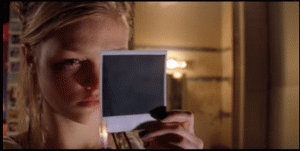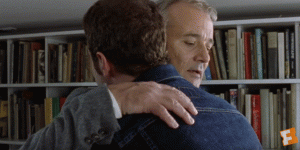Hamlet – the play in which (spoiler alert) almost everyone dies – gets the modern treatment in this 2000 Almereyda film. Elizabethan English muttered by Americans and set in modern New York initially seems “out of joint” and cringe-worthy. However, if you can get over this hurdle, you might be able to appreciate the clever interpretative choices made by the director.
 The film is set in affluent New York with high-rise buildings as the background and limousines instead of horses. Denmark is the name of Claudius’ multi-national corporation and Elsinore is a hotel they live in. Watchingit in 2016, this movie also feels like a throwback to the 90’s, wherein people still used fax machines, owned VCRs, and Blockbusters were still popular.
The film is set in affluent New York with high-rise buildings as the background and limousines instead of horses. Denmark is the name of Claudius’ multi-national corporation and Elsinore is a hotel they live in. Watchingit in 2016, this movie also feels like a throwback to the 90’s, wherein people still used fax machines, owned VCRs, and Blockbusters were still popular.
Hamlet (Ethan Hawk) in this adaptation is a filmmaker. His love interest, Ophelia (Julia Stiles), is a photographer. These interpretative choices by the director are anything but trivial. In fact, they are quite clever. A movie (within a movie), instead of a play as per the text, is what Hamlet uses to “catch the conscience of the king”. This not only alig ns with his interest in filmmaking, but it is perfectly apt for this modern adaptation. Also true to her interests in photography, Ophelia in the scene before her death, gives out Polaroids to Claudius, Laertes, and Gertrude, instead of flowers (like in the text).
ns with his interest in filmmaking, but it is perfectly apt for this modern adaptation. Also true to her interests in photography, Ophelia in the scene before her death, gives out Polaroids to Claudius, Laertes, and Gertrude, instead of flowers (like in the text).
Almereyda brilliantly exploits the possibilities of a modern adaption, as further evidenced by the “get thee to a nunnery” scene. Instead of spying in person, Polonius and Claudius make Ophelia wear a wire to listen in to her conversation with Hamlet. Additionally, Hamlet continues his “get thee to a nunnery” monologue to Ophelia through the answering machine. These clever additions of somewhat modern technology allows the adaptation of Hamlet into the 21st century to be so seamless, such that one can even believe that Hamlet’s story can occur in our times.
The iconic soliloquy “to be or not to be” is what will make or break any adaptation – modern or not. Kenneth Branagh’s marathon-long Hamlet used multiple mirrors as a backdrop when he gave the soliloquy to accentuate his performance. Almereyda utilizes the action aisle of a Blockbuster store. Knowing the importance of the soliloquy, a not just a voice over is given, rather Hawke’s Hamlet acts it out as he walks in the store. It’s not the delivery that makes the scene entertain ing, rather it’s the setting. The background is littered with “action” signs and a large signboard which says “go home happy” hangs from the ceiling. These signs are juxtaposed against the internal state of Hamlet – he lacks action nor is he happy in his home. The irony of the scene makes the film all the more entertaining and enjoyable to watch.
ing, rather it’s the setting. The background is littered with “action” signs and a large signboard which says “go home happy” hangs from the ceiling. These signs are juxtaposed against the internal state of Hamlet – he lacks action nor is he happy in his home. The irony of the scene makes the film all the more entertaining and enjoyable to watch.
While Almereyda’s interpretative choices bolster the film, the acting is somewhat questionable. The more Hawke spouts Elizabethan English, the less likely I am to believe him as Hamlet. When I read the text, I could understand (dare I say, sympathize with?) Hamlet’s mental disposition and lack of action. However, Hawke’s Hamlet is jarring and unlikeable, such that more than halfway through the movie, I began rooting against him. One example is at the first part of the movie, in which Hamlet, Gertrude, and Claudius are in a limousine on their way to a press conference. Hamlet immaturely sulks and pouts as he watches his uncle and mom be affectionate towards each other. In the critical “to be or not to be” soliloquy, Hawke appears more like a lost child, instead of the frustrated young man he ought to be.
The supporting cast makes up for Hawke’s shortcomings. Stiles shines as Ophelia, wherein she plays her innocence and strength seamlessly. When her father and brother advise her to stay away from Hamlet, her subtle defiance is evident. One can witness the range (confusion and frustration) of emotions that plays across her face. Bill Murray also makes a convincing Polonius. Just like in the text, Murray (via subtle emotions) effect ively plays Polonius as someone who does not practice what he preaches (evidenced by the “to thine ownself be true” speech that he gives to Laertes). Hawke’s Hamlet even pales in comparison to Steve Zahn’s Rosencrantz. Even with meagre screen time and short lines, the audience can already sense his ulterior motives (unlike Hawke’s whose performance is questionable at best).
ively plays Polonius as someone who does not practice what he preaches (evidenced by the “to thine ownself be true” speech that he gives to Laertes). Hawke’s Hamlet even pales in comparison to Steve Zahn’s Rosencrantz. Even with meagre screen time and short lines, the audience can already sense his ulterior motives (unlike Hawke’s whose performance is questionable at best).
Despite the poor performance by the titular character, the clever additions and modifications should be good enough reasons to watch the film!
Media:
- http://2damnfunny.com/wp-content/uploads/2013/07/The-Blockbuster-Video-Store-Signal-Around-The-World.jpg
- https://www.youtube.com/watch?v=1pk1Sso8ddg
- https://www.youtube.com/watch?v=EzxET3KpvSM
- https://www.youtube.com/watch?v=1Up-oGfiosE
- http://gifmaker.cc/PlayGIFAnimation.php?folder=2016060810E1FjbuVa8QugoLMdhzQuhx&file=output_T1rfAo.gif
By: Maria Servito
Leave a Reply
You must be logged in to post a comment.